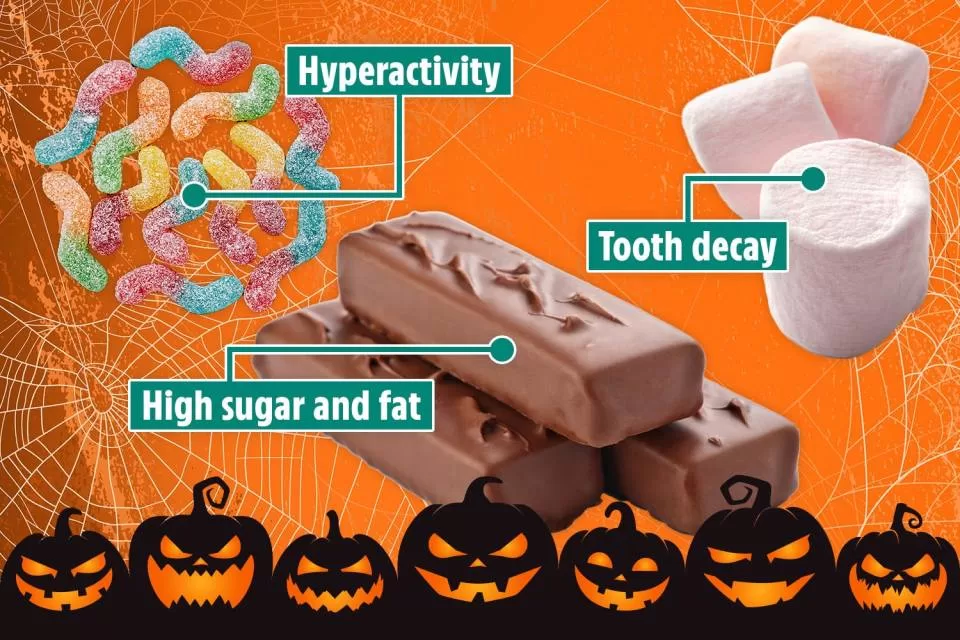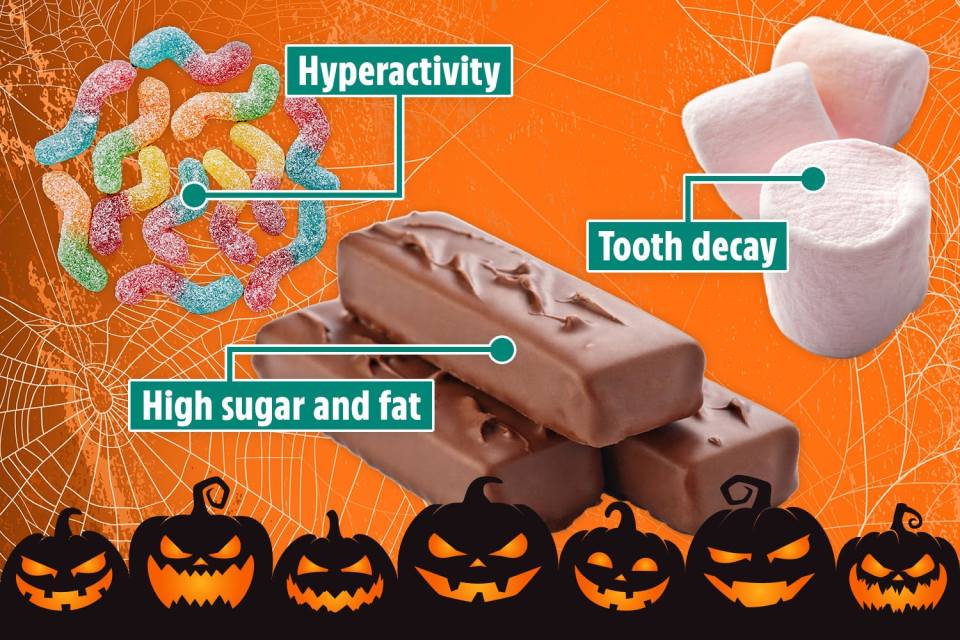ALONG with carved pumpkins and scary costumes, Halloween means kids getting their hands on a devilish amount of sweets.
You won’t want to dampen your tot’s excitement around the spooky season.
After all, how often are they let loose on a bucket of jelly sweets, chocolates and lollies?
But with record levels of childhood obesity and tooth decay, parents must be vigilant of the worst offending foods.
Childhood obesity raises the risk of killer conditions such as heart disease, type 2 diabetes and cancer in adulthood.
Registered nutritionist Rhiannon Lambert tells Sun on Sunday Health: “UK rates of childhood obesity are alarming, with one in three children leaving primary school overweight, and one in five obese.
“When it comes to Halloween treats, it’s important for parents to strike a balance between fun and health.”
Ultra-processed foods contain several unnatural ingredients, such as additives, emulsifiers and preservatives, and often high levels of sugar, saturated fat and salt.
Chocolate bars, for instance, “combine high amounts of sugar with fats from ingredients like caramel or nougat, creating a calorie-dense product with very little nutrition,” Rhiannon says.
But UPFs, which also include foods such as chicken nuggets, fizzy drinks, some yoghurts, breads and condiments — make up a huge portion of British diets.
Toddlers get 47 per cent of their calories from UPFs, according to a study by University College London, rising to 59 per cent by the age of seven.
Rhiannon warns: “These foods are now being linked to an increased risk of chronic diseases later in life, such as heart disease, diabetes and others.”
Research has also found a possible link between artificial colours — which give chewy and gummy sweets their bright hues — and hyperactivity in children, the NHS reports.
Colourings also draw kids’ attention — think M&Ms, Smarties and Skittles.
Rhiannon says: “Bright colours and sugary taste can really appeal to kids, triggering the brain’s reward system and encouraging cravings for more sugary food.”
CHEW ON THAT
EATING sweets causes hyperactive sugar highs, then lows.
Rhiannon says: “Frequent consumption of sweets causes rapid spikes in blood sugar, followed by energy slumps, which can negatively affect children’s mood, behaviour, and focus.
“For children, especially those in school, this rollercoaster of energy can make it harder for them to concentrate.”
It’s not just kids’ waistlines that sweets are detrimental to, but their teeth.
Last month NHS England data revealed tooth decay is the leading cause of hospital admissions among five to nine-year-olds, with almost 19,400 in 2023/2024.
There were 47,581 tooth extractions in NHS hospitals in England for under 19-year-olds last year, two thirds of which were due to tooth decay, figures from the Office for Health Improvement and Disparities show.
Dr Nyree Whitley, chief clinical officer at Mydentist, says: “Sugar interacts with the bacteria in plaque to produce acid, which dissolves tooth enamel and create holes or cavities.”
The worst offenders? “Caramels, toffee apples, lollipops and toffee,” Dr Whitley says.
Rhiannon says: “Chewy candies like toffees are particularly bad for dental health. They stick to teeth and are hard to remove through brushing alone.
“Since lollipops dissolve slowly, they bathe teeth in sugar for extended periods.”
Their stickiness means marshmallows are particularly harmful to children’s teeth, Rhiannon says, while sour candies combine high levels of sugar with acidic ingredients that can be incredibly harsh on tooth enamel.
HEALTHIER HALLOWEEN
KIDS can still enjoy a sweet Halloween while learning the concept of a balanced diet.
Healthy recipes online include fruit kebabs — a mixture of nutritious fruit topped with a ghost-face marshmallow.
Slather a rice cake with peanut butter and use raisins or banana slices to create fun Halloween faces, or use pumpkin fruit for pumpkin brownies.
Dr Whitley recommends indulging in sugary delights only after eating a nutritious meal.
She says: “This is when saliva production is at its highest, helping to protect teeth.”
Fibrous foods like vegetables also reduce the blood sugar spike — preventing your child from a manic sugar high.
Dr Whitley adds: “Kids should brush their teeth twice a day, but wait at least an hour after eating sweets. Bacteria in plaque use sugar to produce acid and their enamel will temporarily be softened.
“Brushing teeth right after eating sugar will spread the acid around and could cause damage to enamel, which is crucial in shielding their teeth.”
Curb your child’s sweet tooth with unprocessed sugar such as fruit, raisins, honey on Greek yoghurt or a trail mix.
Although sweets are the default for trick-or-treating, you could also hand out Halloween-themed stickers, colouring sheets, temporary tattoos, toys or stationery, Rhiannon says.
“These are still exciting without the added sugar concerns, and kids enjoy getting something unique!”


